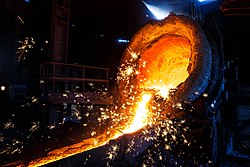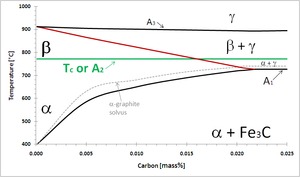Beta ferrite
| Steels |
|---|
 |
| Phases |
| Microstructures |
| Classes |
| Other iron-based materials |
Beta ferrite and beta iron (β-Fe) are obsolete terms for the paramagnetic form of ferrite (α-Fe).[1][2] The primary phase of low-carbon or mild steel and most cast irons at room temperature is ferromagnetic ferrite (α-Fe). As iron or ferritic steel is heated above the critical temperature A2 or Curie temperature of 771°C (1044K or 1420°F),[3] the random thermal agitation of the atoms exceeds the oriented magnetic moment of the unpaired electron spins in the 3d shell.[4] The A2 forms the low-temperature boundary of the beta iron field in the phase diagram in Figure 1. Beta ferrite is crystallographically identical to alpha ferrite, except for magnetic domains and the expanded body-centered cubic lattice parameter as a function of temperature, and is therefore of only minor importance in steel heat treating. For this reason, the beta “phase” is not usually considered a distinct phase but merely the high-temperature end of the alpha phase field. Similarly, the A2 is of only minor importance compared to the A1 (eutectoid), A3 and Acm critical temperatures. The Acm, where austenite is in equilibrium with cementite + γ-Fe, is beyond the right edge in Fig. 1. The α + γ phase field is, technically, the β + γ field above the A2. The beta designation maintains continuity of the Greek-letter progression of phases in iron and steel: ferrite (α-Fe), beta ferrite (β-Fe), austenite (γ-Fe), high-temperature delta ferrite (δ-Fe) and high-pressure hexaferrum (ε-Fe).
A2 critical temperature and induction heating
Beta ferrite and the A2 critical temperature are very important in induction heating of steel, such as for surface-hardening heat treatments. Steel is typically austenitized at 900-1000°C before it is quenched and tempered. The high-frequency alternating magnetic field of induction heating heats the steel by two mechanisms below the Curie temperature: resistance or Joule (I2R) heating and ferromagnetic hysteresis losses. Above the A2, the hysteresis mechanism disappears and the required amount of energy per degree of temperature increase is substantially larger than below A2. Load-matching circuits may be needed to vary the impedance in the induction power source to compensate for the change.[5]
Beta iron in geology
Saxena, Dubrovinsky et al. of Uppsala University observed x-ray diffraction (XRD) evidence of a high-pressure, high-temperature phase they designated as beta iron (β-Fe).[6] A foil of 99.9% pure α-Fe was compressed in a diamond anvil to 35-40 GPa to form the standard high-pressure phase, hexagonal close-packed (HCP) ε-Fe. The ε-Fe was heated with a laser to a temperature near 1500 K, scanned via XRD, quenched and re-scanned. The β-Fe phase was modeled as a four-layer HCP superlattice,[7] and was proposed as a possible phase in Earth’s iron core. Subsequent studies were unable to reproduce β-Fe or a similar orthorhombic phase, and these phases came to be regarded as either metastable or incorrectly identified.[8]

References
- ^ D.K. Bullens et al., Steel and Its Heat Treatment, Vol. I, Fourth Ed., J. Wiley & Sons Inc., 1938, p 86.
- ^ S.H. Avner, Introduction to Physical Metallurgy, 2nd Ed., McGraw-Hill, 1974, p 225.
- ^ a b ASM Handbook, Vol. 3: Alloy Phase Diagrams, ASM International, 1992, p 2.210 and 4.9, ISBN 0-87170-381-5.
- ^ B.D. Cullity & C.D. Graham, Introduction to Magnetic Materials, Second Ed., IEEE Inc., 2009, p 91, ISBN 978-0-471-47741-9.
- ^ S.L. Semiatin & D.E. Stutz, Induction Heat Treatment of Steel, ASM International, 1986, p 95-98, ISBN 0-87170-211-8.
- ^ S.K. Saxena, L.S. Dubrovinsky, P. Haggkvist, Y. Cerenius, G. Shen & H.K. Mao, "Synchrotron X-ray Study of Iron at High Pressure and Temperature," Science, Vol. 269, 22 Sep 1995, p 1703-4.
- ^ Powder Diffraction File 00-050-1275, International Centre for Diffraction Data, 1998.
- ^ Y. Ma, M. Somayazulu, G. Shen, H. Maob, J. Shub & R.J. Hemley, "In situ X-ray diffraction studies of iron to Earth-core conditions," Physics of the Earth and Planetary Interiors, Vol. 143–144 (2004) p 455–467.
